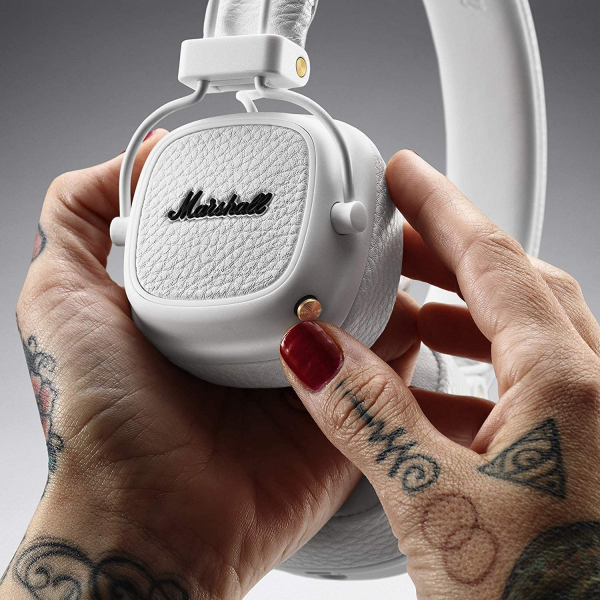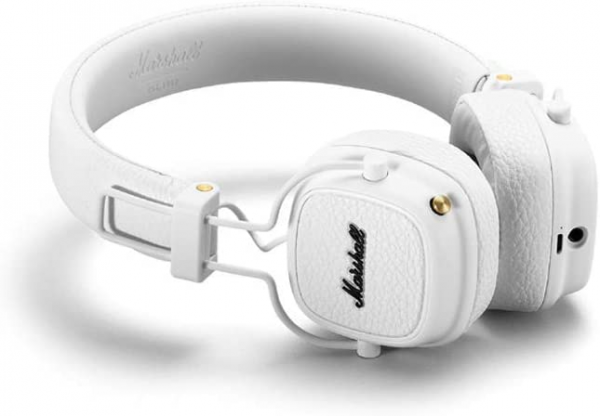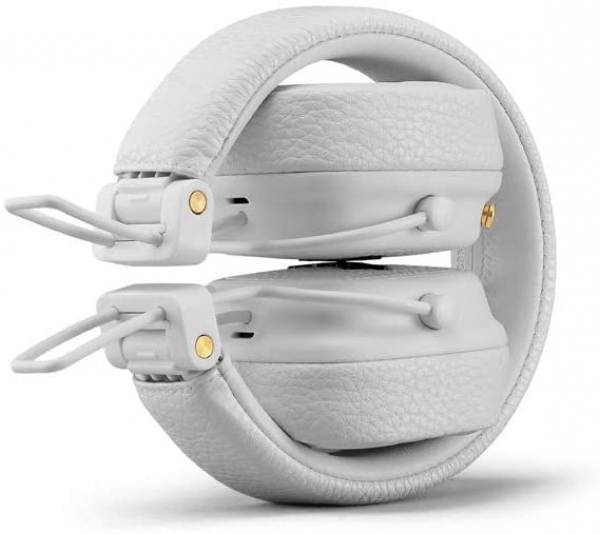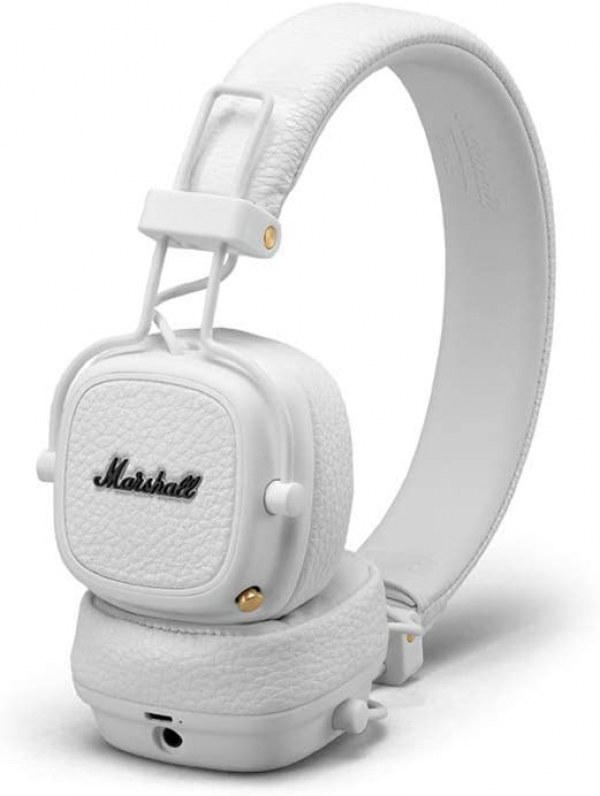Marshall
Marshall Major III Bluetooth headset: mixed developments
Aprox. 99€ - see price -
The Major is undoubtedly the most popular helmet from Marshall, and one of the few that has been able to boast of competing with Beats in terms of popularity. If, like his rival, his first models had not convinced us, Marshall (that is to say Zound Industries) has raised the bar, especially with the Major II Bluetooth. Let's discover together what the III has in store for us ...
Our review
Ergonomics
Unlike those of all products in the latest Marshall range (including the Mid ANC), the logo of the Major III Bluetooth was not given a facelift. Why, we do not know, still it is that instead of adorning itself with the soft bronze shade, it remains confined to good old white plastic.
In accordance with the manufacturer's promises, the helmet design has been reworked, in a subtle but undeniable way. Marshall makes a definitive cross on the ovoid shape of the hoop so criticized and gratifies his newborn with considerably thicker pads. All this offers undoubtedly superior comfort to previous models: the support is very good, while avoiding the pincer effect thanks to the better distribution of the pressure on the skull and the softness of the pads. After five or six hours, however, a slight discomfort may be felt in the cartilage.
The distribution of commands has also been redesigned: the helmet is now fully controlled from the multifunction button, responsive and intuitive. A long press turns it on / off, a long press turns it on and activates Bluetooth pairing, the longitudinal axis (up / down) allows you to adjust the listening volume and the anteroposterior axis (front / back), to navigate between the tracks . Finally, a simple press allows you to take / reject calls and a double press invokes the personal assistant of your chapel.
Like that of the majority of wireless headsets, the hands-free kit of Major III Bluetooth fails to offer good intelligibility. The attenuation of the parasitic noises is not satisfactory, and the voice of the user suffers from this famous "underwater" effect, very close to a quantization noise.
We can also observe more surprising developments, such as the disappearance of metal rings that conveyed the spirit and aesthetics of the amp manufacturer. It turns out that the hinges have been completely modified to lighten and offer better ergonomics and longevity to the foldable helmet. By the way, the indication of the left / right channels is now soberly engraved on the imitation vinyl fabric, as is the logo under the arch which no longer spreads in flaming letters. Marshall promises increased durability of his helmet, the only promise that we can not verify during a test, but it must be said that over the years, we have already noticed very little deterioration on previous models.
The supra is accompanied by a twisted cable in the event of a battery failure as well as a micro-USB charging cable, with connectors always screened. In terms of autonomy, the Major III Bluetooth is worthy of its august lineage by ensuring more than thirty hours of wireless music on a single charge (38 hours at 75% of maximum volume).

Audio
It's not just the design of the Major that changes: Marshall also equips its latest model with new "optimized" transducers promising a crystal-clear sound, better defined, with improved low frequency power - in short, a V signature.
And V signature there is! This is almost a 180 ° turn for Marshall, whose headsets were known on the contrary to highlight (sometimes too much) the midrange. As always, the frequency response curve announced is fully in line with the results of our measurements: flattered bass, low mid / low midrange, then high backward midrange. While the previous models gave pride of place to the frequency range between 1 and 2 kHz, it is now that between 2 and 5 kHz that gives voice, or rather cymbal. Unlike Marshall, we would not call this rendering "crystalline" (as a Sony or an Audio-Technica can be), but rather "pinched", even slightly garish. Fortunately, it flirts with shine, certainly, but never becomes truly aggressive and spares our eardrums the joys of sibilance. On the other hand, all the breaths, the "ch", "f", "s" are propelled to the front of the stage, impossible to ignore.
That being said, the bass, despite a certain roundness, is well controlled, surprisingly clean and dynamic on the attacks. The mediums, although in retreat, are in no way relegated to the last row and remain perfectly intelligible. The precision is rather good in the bass and treble, less convincing in the mid / high mids, especially on sources mixed in the background, or when the instrumentation is particularly rich.
The explanation is also on the side of the harmonic distortion rate, exemplary throughout the spectrum except around 4 kHz (in Bluetooth), where it gets carried away a little. The stereophonic scene is quite ample and clearly detailed, helped by an excellent separation of the left / right channels, in Bluetooth as in wire. The power in Bluetooth is astounding: at maximum volume, the Major III Bluetooth only requires 70 mV (against 100 to 150 usually) to reach 94 dB SPL in our model's ears.
Latency is finally measured at 140 ms, a value quite average but too high for us to watch videos without perceiving the difference between image and sound. To remedy this, we recommend using software to adjust this offset (such as VLC), or to switch to wired listening.

Conclusion
Many elements have been redesigned by Marshall since the Major II Bluetooth - some to the advantage of Major III, like comfort, others more questionable, like the new transducers. In addition, we find the rock'n roll aesthetic, the excellent autonomy and the complete and intuitive management of orders. The III and II therefore each make valid arguments, which will give advantage to one or the other depending on the needs and expectations of the user.

Reviews


Thank God they are real!!!!
I'm not going to lie ...... I was nervous with all the fake Marshall headphones circulateing, I knew this could be a risk. They are 100% authentic. Sound quality is exactly what I expected from the Marshall brand. Easiest way to know if they are real is if the headphones support aptx audio. Once paired with an Android phone, it shows under the Bluetooth option when you click on the headphones. I enclosed a pic. I hope this review helps. Be careful with other sellers.
If you're a pop iconoclast looking for high quality earphones - look no further
I was originally planning to use these in a studio setting as drummer headphones. However, the minor delay inherent with Bluetooth prevented that. So I had to repurpose them for general use which was a blessing in disguise. I'm absolutely thrilled with the quality, fit, weight, and sound of these headphones. I take them with me everywhere now. Bluetooth connects every time with no issue and battery life is stellar (now that I think of it, they've never run out on me). Most notable, they live up to the iconic brand that adorns the cup by being the most durable headphones I've ever owned. You may experience some ear fatigue if you where them for hours at a time, but that's simply the byproduct of on-the-ear headphones.
Rockin’!
Love these headphones! Pulled them out of the box and the Bluetooth worked for three hours without charging them the first time (I finally turned them off after three hours because I couldn't rock anymore). The headphones fit very snug against the head / ears. I usually like to wear my headphones a bit lower on my head, but for these to be comfortable, you may need to adjust them higher up than you would expect to evenly distribute how the padding hugs your ears. After I did that, no problems with comfort. Even though these are not noise canceling, they do block out sound very well. It's not easy to hear someone talking to you even when music does not play. I have a pair of thick-frame glasses I wear when I'm not wearing my contacts; I did eventually take my glasses off because the headphones are so snug I felt like they were pushing my glasses too hard against my head. May not be bad if you have thin glasses, but thick frames were uncomfortable. Other than that, they're great for listening to Montrose! One cool feature that isn't entirely played up on these is that someone else can plug their headphones into these so you can “share” your music; no more giving someone the left earbud while you listen to the right earbud! Good stuff.
Very disappointing - They cool, but that's about it.
I had high hopes for these cans after buying Marshall's Kilburn 2 BT speaker. While that little bit of kit sounds sublime, these sound like garbage. Anemic congested low end, brittle highs, and a harsh mid-range. What's up with that Marshall? You nailed it on the smooth sounding Killburn speaker, so we know you are capable of producing excellent consumer audio. IA / B tested these against bottom of the line Grados and there is no comparison - the cheap Grados blow these out of the water. Granted, the Grado's are corded, but even hardwired through the included cable, these sound thin and harsh to my ears. Oh, and they hurt.
Maybe they are counterfeit?
At any rate, they are going back ....
Great Headphones
I truly enjoy these headphones.
The charge last long, and it works great with the cord when the charge is out.
The sound is great when listening to music or watching a movie.
Feel very comfortable, not too tight on my head.
The whole earpiece fits on my ear, which I prefer, and I don't have a issue when wearing earrings.
They fold up and are easy to transport.
Also, I love the curly cord, it reminds my of older headphones, just reminiscing.
The cordless range is AMAZING !! I can walk all over my house and have no issues. And it's 2,000 sq feet, not an apartment, so they go pretty darn far.
The bass is not great. I have a pair of Skullcandy Crusher Bluetooth Wireless Over-Ear Headphone, those have amazing bass that can be adjusted, I swear they vibrate on your head. But I don't like that they are over my ears, they feel super tight on my head. I also couldn't wear earrings with the SkullCandy. Plus, the cordless range on the SkullCandy sucked compared to the Marshall.
Over all, they are great for everyday use, comfortable, and have amazing range.
Good brand at a good price.
Out of the box instant review. Charged to full very quickly. Paired to my iPhone easily and maintained connection. Felt comfortable to wear and although not sound canceling, they seal to the ear very well and mute the extraneous sounds well. Music sounds fine with good bass and clear midrange. Kind of a bouncy edge to the music. So far, so good.
They don't fit over your ears
These are very high quality headphones with great sound, but the earpieces are too small for your ear to fit inside, so they end up pressing your ear against your head, which I found uncomfortable They aren't over-ear and they aren't the lightweight pads you find in cheaper on-ear phones, the earpieces are substantial and that's the problem.
These are certainly good!!!
I've bought previous on ear headphones before. I currently own a pair of V-Moda xs that I really love. Sadly the xs are not wireless. These Marshalls are just as comfortable, they are wireless, and sound really good for half the price. These cans are built with high quality materials for the price. I sure couldn't find anything better with the amount of features and sound for $ 100. You really can't go wrong with these.